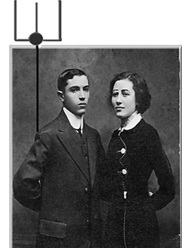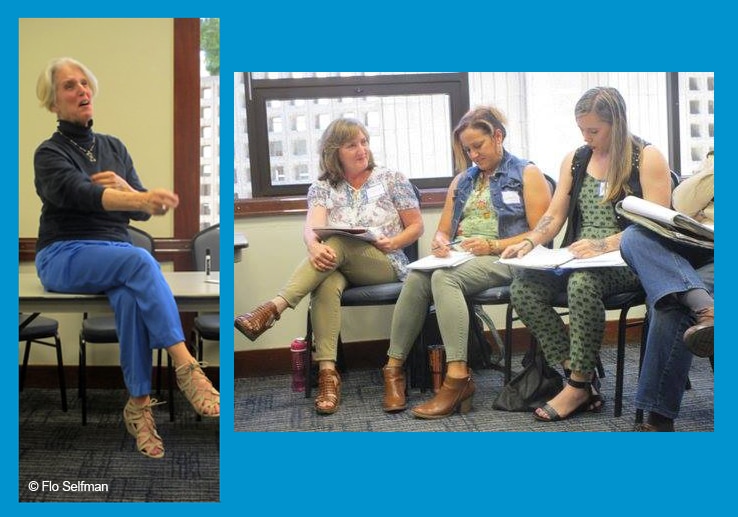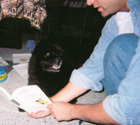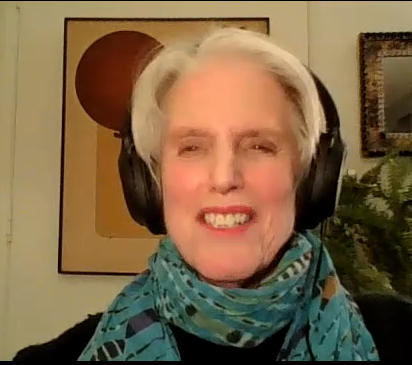All were looking for a way to figure out how to really get going on a book they've had in mind, but somehow have not been able to bring to fruition.
We spent time with each person, reviewing reasons why one or another of the books banging them upside the head weren't really taking shape. Turned out, it was usually more than one book each person had been thinking about, sometimes for years. Does this sound at all familiar? Have you got three or more books you've started to write, put down, picked up again maybe once a year? Have other books jumped up and demanded you tackle them, now? You are not alone! Ask yourself these questions:
Think about your answers. The solution to which book to start with should become clear. My main point is this. Put your focus on one book at a time. That does not mean the other books won't intrude and want to make themselves heard. Be kind to them. Write down a few notes that they're whispering in your ear, put them in a separate file, and then go back to the one you have selected to do first. Then what? Keep writing. On the chosen book! Stay focused. Make dates with yourself to write regularly. Carve out a time. You deserve it! Yes, you can fit in other parts of your life. They're important! But stick with your promise to yourself. Write. Then watch the pages mount up. If you would like concrete ideas on how to stay motivated, how to keep yourself in that chair, how to keep the focus on one book at a time, and how to make that book richer and a better read, join the workshop I'm starting at the end of July! We'll be working with folks who have picked a book to really dive into. And want to take it to the next level. For dates, times, other info, and sign-up use the button below. At the end of the Jump Start Your Book workshop, the path seemed clear for attendees. And now, I'm looking forward to seeing progress as these people hone in on the book that makes the most sense to start with. And you, too, if you were not at our June 17 Jump Start Your Book! event. This is a limited seating series, and a few seats are available for those who have not attended but have a book they want to develop further.
3 Comments
Just Write! Or, How to Go From One Blank Page to a Full Manuscript without Tearing Your Hair Out6/24/2016 I wrote about breaking through writers block back in 2011. But it's such a recurring theme I wanted to post an update, with some new "why I can't write" protests, and tips on why, and how, you can write. Blame the students in my Monday morning memoirs class, who expressed frustrations along these lines. But here's the thing -- when I talked to them about ways to move on, there was a palpable change in the room. A huge sense of relief, and excitement.
This is how the discussion started. Seem familiar? "I'm afraid to write about my life. If I go into the feelings, I won't be able to deal with it...Too much pain. I just don't want to go there." Then there was damned if you do and damned if you don't: "I want to write my memoir, but I'm afraid that if I get into the story, hours will go by and I won't be able to get anything done. That happened to me recently. I started to write, looked up at the clock, and it was three hours later. I can't afford that kind of time! I promised to do things for my husband, and other people, and I have laundry, shopping...." So, here's what I said to the first issue. I know it's hard to write about painful memories. But once you get them out on paper (or computer screen), you'll feel so much better. It's really cathartic. Writing is a recognized technique for overcoming the pain of loss. There is much written about this in the literature of social services and psychology. I'd used the technique in my Grief Lifters classes. So I'd also had experience helping others release pain through writing. Several in the class nodded when I mentioned the power of writing to help ease the pains of old hurts. One long time class member and I recalled Kay. A wonderful writer, not suffering from a block, but she did feel pain, acutely, when writing some of the stories of her life. She, and the rest of us, learned that the first time she read one of these tales, she'd cry. The second time, the crying would happen, but less of it. The third time, no tears. The same thing happened over and over. Kay knew how healing it was for her to write these memories down. And so did everyone else in the class. A lesson they applied to their own work. Another member had lost his wife. Writing helped him get through the pain. And it had another benefit. It brought him close to two of his estranged daughters. They'd never known how much he cared for their mother; he was schooled in the "Don't show your emotions" school of family life. But when they read these stories, his kids all realized that indeed, he loved his wife very much. One other, important benefit of writing about painful experiences. The way you got through them can help those who read your stories. Perhaps you'll be able to show them a technique for coping that helped you. And just the fact that you got through it can buoy a reader's spirits. I also told the class a story about one of my own experiences. I was in a relationship with a fellow, and it was quite serious. Then one day he didn't show up. Something told me he never would. And I was right. I was in such pain when I realized this that I jumped into my car, with no idea where I was headed. This was Carmel. Beautiful area, with small towns and roads right on the Pacific coast. A spot in nearby Pacific Grove called out to me. I parked, sat, and stared at the ocean. Somehow I'd taken a yellow pad and pen. I picked them up and started to write. One hour later, the tablet held twelve pages of hardly crossed out handwriting. I began to read. "You know I'll never hurt you," my former lover said to me in the first line. Reading all the pages, as if outside myself, I morphed into a reader of someone else's prose. "Not bad," came to mind. I realized this was the beginning of a book. And that clearly the process of writing had defused the pain. Once people realize how useful writing is at getting over deep wounds, it becomes easier and actually logical to just dive in. I encourage you to try it. Please let me know how it's going for you! Comment here or send me an email. On the second issue, "I'll get lost in the writing and won't be able to get anything done -- promises I made to others, or chores for myself" -- here was my reply. This is a common roadblock people throw up to keep from putting pen to paper. But you do not have to lose yourself in your writing. You can set a time limit. Also, while we all make promises to other people, it's important to do things for ourselves as well. Remember, the writing is something you want to do, for yourself. You've stated that you want to get your stories down so that others in your family will know what you've done in your life. Some of you want to get your stories published, and perhaps performed. How to avoid being swallowed up? Try using a timer. Figure out what amount of time is right for you. Can you give yourself one hour a day? Or one or more hours once a week? This has to be sacred time. Nothing can interrupt. Think of it as a gift and a promise you are giving to yourself. You deserve it. Whether you've had either of these reasons to keep from starting or keeping on, or others, you'll find that once you start, you'll want, and even need, to keep on going. Persistence really does pay. The pages will pile up. If you just write.
Here are a few articles on the subject:
Psychology Today Forbes The Atlantic The other good thing about exposing yourself on paper is your readers will admire your honesty. The writer who is not perfect is human. Someone with whom a reader can honestly identify. When I wrote my first book, Pawprints, I was quite pleased when friends remarked, "I can hear you talking as I read these stories." But I was actually surprised and a bit uncomfortable myself when people added, "I know so much more about you now," with a kind of knowing look. Ouch! But, the fact that I did reveal personal vignettes did much more for me than to me. Pawprints became an Amazon.com bestseller, and developed into a literacy program. And readers liked me! Now, does this mean you have to tell everything? No. If you will really hurt yourself or someone else, consider whether or not it is such an important point that you must reveal all. If so, the other people who are afraid they might be tarnished by association, or whose secret you are telling, will just have to get over it. This is particularly true within families. There are always skeletons and everyone is afraid of letting them jump into the light. But, as the research shows, these secrets are harmful to everyone, and it really may wind up helping all involved if the cat is let out of the bag. Thinking over your life for your memoir will bring to mind these secrets. And while it is a good thing to put some into print, there are valid reasons when other avenues at clearing the air may be a better choice. A woman who came to me about a project had experienced the family secret issue. A relative was trying to urge her to have sex with his friends, who were strangers to her. Why? Probably because he thought "free love" was healthy. She was so offended, and upset, that she chose to ostracize him, and never re-opened the door to the man again. The rest of the family knew nothing of this. They were all very upset with her. In talking about her project, we discussed this issue in depth. The conclusion -- it would be too hurtful for the family to include the episode and its aftermath in her memoir, and it was not critical to the portion of her life about which she was writing. But it was important to talk to others in the family once he had died. They needed to know why she had seemed so ill mannered, to say the least. The result? Suddenly, the family understood her behavior. They wound up embracing her warmly. Family bonds were re-attached. Another time you might opt not to include such a secret is if you might wind up getting hurt, for example kneecapped, as one lady who came to me for advice might have. In this case I also advised not to reveal the secrets.These were not about the author, but about characters she would include. The woman with the story had been married to a man who was famous in a field that was riddled with mafia. It would have been very dangerous for her to expose their behavior. On a related note, is it OK to write stories about celebrities you might have encountered? In general, the rule of thumb is, if it really happened, it is not libel (“slander” refers to telling the story orally) and you can write it. Celebrities are also considered public figures and as such are “fair game” for irony, or for stories that involve something you witnessed – as long as it is not degrading or defamatory. They are not, though, fair game for mean spirited, untrue stories. Again, if it is not true, you better watch out. Here are two resources online to check out the legalities involved. Findlaw.com Nolo The short answers: Use dialog to signify moods/feelings. Or, as an example of making words bounce off the page, Pepper Your Life Stories with Dialog to Add Zing Life story writing certainly begins by describing events and people we have encountered, but how do we make these stories more than just a -- sorry, the word is dull -- recitation of facts? And an equally dull series of descriptions of how a character feels? These are questions that come up often among people in my classes, and in private coaching. My recipe is, first, to capture and record dialog. If you don’t remember exactly what was said, that’s alright. Create conversations that come as close as possible to what you remember. A great technique for writing dialog is to imagine you’re talking with a friend. Second, remember to keep your dialog in character. Each person you write about talks in a way that is specific for that person. Not everybody is from Australia, for example. So not everyone will greet another character with the phrase, “G’day, mate.” But if you have an Aussie you’re quoting, this would be a valid and lively phrase to use. A very good way to get a handle on using dialog in writing a book of your life stories is to read samples from a few autobiographies or memoirs before plunging back in to writing again yourself. This is not at all to say that you have never read a book. Far from it. Refreshing/immersing yourself in a genre is a tool that most writers (including me) use to get themselves in the groove of writing in a particular form. I have a great book to recommend. It's Steve Martin's autobiography, Born Standing Up. If you go into the library (while they still exist) and browse the biography section, you can find many other books that will contain a mix of prose and dialog that should help inform your writing. OK. So we insert dialog, but now, how much dialog is too much/too little? This related question comes from a very talented, very funny woman I coached. Her initial submission was a 25 page listing of the events in her life. It was not an easy life story -- she had a serious illness. But she treated each (often frightening) milestone with enormous good humor. Nonetheless, the result was far too much on the surface. We never knew how the main character was feeling. I suggested she insert dialog. The student came back in a very short time with an entirely new book – laced with so much dialog we now weren’t sure what the action was. So, the challenge became finding a balance between description and dialog. While there are no real rules on proportions of prose to conversation, basically, the idea is to arrange dialog snippets within descriptive sections of an episode in your book. The dialog can then be used as a tool to expand the story in a way that literally speaks to readers. Here’s a sample: Tom yelled at Sarah, "You're a spiteful, ugly witch, and I'm sick to death of being around you!" Sarah slumped into the tub chair in her living room as he uttered his horrid words. Frozen, she was unable to move or speak. Tom waved his arms in the air for a minute, then slammed out the door. Sarah knew it was for the last time. Now, we could follow with: Sarah felt terrible. Or, we could insert a phone call from a girl friend. From somewhere outside her consciousness, Sarah heard a persistent, repeating sound. Rousing, she realized it was the phone. She slowly dragged herself to the instrument across the room and picked up the receiver. “Hello,” Sarah mumbled, barely audible. “Hi, Sarah? You don’t sound like yourself. Are you alright?” Sarah realized it was her BFF, Kim. She let go, sobbing into the phone. “Sarah, Sarah! What happened?” “T…T…Tom. He…he… left…me!” “What are you talking about? What happened?” “He called me names, said horrible things, and slammed out.” “Oh, he’s gotten mad at you before. He’ll be back.” “Not this time.” “How do you know that?” “I don’t know. It’s just the way he said it. This time he’ll never come back…I know it. What can I do? I don’t know how I’ll be able to go on without him. After all these years.” “Listen, honey. I can tell you feel terrible. You shouldn’t be alone. Do you want me to come over?” Etc. Finish the dialog on the phone yourself! With a very short additional couple of lines. Which method do you find makes for a better read? KEY WORDS: writing; writing coach; memoir writing; how to write your memoirs; writing dialog; dialog writing tips; character development in writing; InaTheMemoirCoach _ Certainly words such as “the” demand to be used more than once. That’s not boring unless they show up as every other word; they’re not eye-catchers. But if you have used a descriptive, colorful or unique term, for example you’ve described someone as “fascinating,” be sure you don’t use the word, in any of its versions, later in the same sentence or paragraph. You will soon disengage your reader.
Less Interesting: Old Weird Harold was the most fascinating kid on the block. For one thing, what kid would have a name that fascinated people like that? Way to go: Old Weird Harold was the most fascinating kid on the block. For one thing, what kid would have a name like that? (adapted, with gratitude, from a phrase by Footprints author, Kay Roberts) Less interesting: Old Weird Harold always wore a brown fedora on his head. Every time he took his fedora off, the young man bowed. Way to go: Old Weird Harold always wore a brown fedora. Every time he removed his signature head ornament, the young man bowed. *Excerpt from How To Write Your Memoirs...The Toolbox Edition, upcoming sequel to How To Write Your Memoirs...Fun Prompts to Make Writing...and Reading Your Life Stories a Pleasure! Have you got a pet paragraph you'd like to send us to show how you've avoided this potential reader turn-off? Please send it to us in a comment below. Thanks!!!! Thought I'd get back to posting some memoir writing tips. This one deals with a frequent issue many of us face when creating a memoir, or for that matter, any form of writing.
Do you find that a bunch of totally different adventures and people keep jumping into your thoughts as you’re trying to write a story? Don’t let that throw you into a tailspin. When you’re working on one chapter or idea and another crops up, just take notes on a separate piece of paper (or separate document if you’re on the computer). That way, you can get back on track quickly, yet not lose the “intruding” idea. And later, you’ll be able to develop and maybe incorporate that idea, too. This tool has been very helpful to me, and to members of my Footprints Writing Club. For example, one man, new to writing, is committed to getting his life story on paper, but at first he had a terrible time keeping to a narrative line. He wrote what happened clearly, in a matter-of-fact-based way, but in a rather stilted tone, devoid of feelings and tension. He also complained that ideas for other parts of his life kept coming up as he tried to write, and he would find it next to impossible to stick with the story he was working on. After a bit, trying this method of jotting down a note about a new idea, and then going back to where he was, his frustration level lowered dramatically, and his writing improved in equal measure. Now when he reads a segment of a new tale, rather than expecting to hear him wade through a rather detailed recitation of events without any plot, the class is eager to know what will happen next. And he feels much more comfortable while he writes. He’s even gotten very good at short fiction. Creating a fun story from a weird prompt is a new talent he didn’t know he possessed. Most of his writing is still carefully geared to “telling it like it was or is,” which is quite interesting in its own right; we his readers are learning about times and places we’d never have known about. But now that he can focus on storytelling, whether he’s writing fact or fiction, it’s a surprise and treat for us all to read or listen to new tales he weaves. The above tip is excerpted from my upcoming sequel, How To Write Your Memoirs, The Toolbox Edition.  I decided it was time to pull out the material I've been sharing in workshops and in private sessions all in one place, to make it easier for those of you who want to write your own memoirs -- if only so the family will quit giving you a hard time already. So, there's a new kid on the block: InaTheMemoirCoach.com. What's the site for? To help kick-start people who have a story to tell, but have been stumped about where to begin, how to organize, or get published. Both new writers and those new to the memoir form will find tools and tips. Or if you're one of those who really wish their parents and grandparents would tell their stories, this is a place to get some ideas of how to help them dig in, for you, but also for themselves. Writing the story of your life does not have to be hard, and it is a way to help others learn from your experience. And a way to clear cobwebs and feel better about life! The new site features a bunch of Ina's Weird Prompts (TM) to help you recall your adventures vividly, and writing tips to help you get them down in a way others will savor. In coming months I'll be featuring the memoir writing experiences of others who have taken the leap. Give it a try -- you could become a featured talent with advice from your journey that will enlighten readers. There is also a page dedicated to giving visitors a chance to ask me questions about writing memoirs, getting them published or printed for personal use, and performing your stories. One last thought -- you don't have to be an old bat like me to write an effective memoir. Remember, everyone has a story to tell.  In the first article in this series, we visited tools to help you get started, and move out of a block. There are many more coming in my next book, "How to Write Your Memoirs...The Toolbox Edition." In this article, we'll focus on ideas to kick your writing style up a notch.
TIPS ON GOOD WRITING 1. Start with a bang, but don’t worry if the gong doesn’t ring right away The first line of any form you choose to write — novel, short story, memoir, poem — has an important role to play: it’s got to hook your reader. But don’t let this hang you up. Sometimes a great first line just comes to us, and in fact gets us going. But sometimes a good one comes later, after the writing has gone a short or even longer way. Suddenly just the right phrase or line will pop up, emerging from the story. You’ll know it when it surfaces. Way to go: Holding onto the strap over her head, Hilda fell right out of the funicular car. What, you ask? How could that happen? Well, perhaps the strap was on its last legs and ripped. Or….you think of another possibility. Less Interesting: Hilda went on a trip. 2. Don’t repeat the same special word or descriptor in a sentence or paragraph. Certainly words such as “the” may demand to be used more than once. That’s not boring unless they show up as every other word; they’re not eye-catchers. But if you have used a descriptive, colorful or unique term, for example you’ve described someone as “fascinating,” be sure you don’t use the word, in any of its versions, later in the same sentence or paragraph. You will soon disengage your reader. Less Interesting: Old Weird Harold was the most fascinating kid on the block. For one thing, what kid would have a name that fascinated people like that? Way to go: Old Weird Harold was the most fascinating kid on the block. For one thing, what kid would have a name that captures attention so immediately? (adapted, with gratitude, from a phrase by Footprints author, Kay Roberts) Less interesting: Old Weird Harold always wore a brown hat on his head. Every time he took his brown hat off, the young man bowed. Way to go: Old Weird Harold always wore a brown hat on his head. Every time he removed his signature head gear, the young man bowed. 3. Keep your tenses straight. This is one of the hardest concepts for many, even experienced writers. Well, I include myself as experienced here. Maybe other experienced writers never have this problem. Anyway, the issue is sticking to either past or present tense, or using the conditional if warranted. To be specific: Wrong-o: Jason went into the forest. He hears a whooshing sound. Right: Jason went into the forest. He heard a whooshing sound. I know, it’s tempting to want to jump into the present tense to make the story more tense. Examine what you mean to say. Maybe you should be writing the whole section in the present tense: Jason enters the forest. He hears a whooshing sound. Just be sure your story hangs together in a timeline. You can certainly move in and out of the past and present, and propel characters into the future in one project. But keep the story line logical by making sure that whichever episode you are describing is clearly in whatever time zone you mean it to be. Next article: Make your story come alive! --------- *The above is excerpted from the upcoming book by Hillebrandt, "How to Write Your Memoirs...The Toolbox Edition" (c) 2012 Ina S. Hillebrandt. All rights reserved. Except for review purposes, not to be reprinted in part or in whole, in any media, without permission from Pawpress. For inquiries Contact Ina  Break through those blocks! Get un-stuck. Pry open those mental doors! It’s one of those days. Or maybe it’s been one of those years. You look at the paper, or computer screen. Nothing. You may be on deadline. You may just want desperately to write something for yourself. Doesn’t matter – nothing is coming up. Maddening, isn’t it? Not the first time, right? And you just know there’s no way out.
Well, maybe that’s not true, even though all the tricks you’ve tried before aren’t working today. You’re looking at this book because maybe, just maybe, there are some ideas that could blast you through that godforsaken wall. I hope these will help. They’re block busters that have worked for me, and for people in the classes I conduct. What we like about them is they don’t take a lot of hard thinking, nor do they require you be in tip-top creative genius form. The expectancy that brilliant genius mode is the only place you should be when you write is probably high on the list of what’s keeping you stuck to begin with, no? So, willing to give it a try? OK, the first trick is to let go. Not just by willing yourself to. You can actually take steps, easy steps, to unwind and move out of the box. Tip #1: Breathing First, sit with both feet on the floor, legs uncrossed. Take a deep breath, in through your nose. Hold it for ten seconds. Release the breath through your mouth. Look at the paper or computer. Write whatever comes to mind. If you’re trying to move ahead on a project and that isn’t what comes up, it’s OK. Do not force yourself to make it about your project. Just write whatever comes to mind. See if it leads you into the project after all. Or if it leads you to a totally new writing path — See Trick #2. Tip #2: Journaling, a way to cleanse the brain and ease into your project Start your day with getting the things that are on your mind out on paper. By simply writing down your first feelings of the day, you will clear your mind of underlying issues, and free your creative self to leap out. As you’re doing this simple exercise, good ideas can spring to life at any time. Another way to think of journaling as a springboard to writing — just do it! Sit down with paper and pencil/pen, or computer, and start writing about what’s going on in your life today. Write for as long as you feel you need, or give yourself a reasonable amount of time, like 10 or 15 minutes. At some point, you may find you’re switching gears and starting or resuming your project. If not, that’s perfectly OK. Just get those often confusing, negative first thoughts of the day out of your head. You’ll find you can tackle your project with a lot more energy. Tip #3: Set a time of day to sit down and write. And stick to it! Get regimented. Make an appointment with yourself, and don’t let anything interfere. If someone wants to meet for coffee, tell them you have an appointment until the hour you have pre-set to stop, and make your coffee date for sometime after your writing date. Now here’s the tricky part: sit in front of the computer or paper for the whole time you’ve set aside. Even if nothing comes, it’s important to keep to the commitment. This is a trick some of the most successful writers have used. It’s the commitment to yourself to write that’s the motivator. Tip #3A Alternate to #3: Set a goal of a certain number of pages, or words, for the day Some writers use this trick instead of choosing a specific time of day. Also, some writers use both time of day and specific number of pages or words. I say, whatever works! Tip #3B Make sure you keep to your stopping point!!! That’s as important as the starting point in keeping you motivated. And remember what Dorothy Parker is supposed to have said, “The art of writing is the art of applying the ass firmly to the seat of the chair.” Tip #4 If you're having a hard time getting started, think back to your very earliest memory. Get as specific as you can. Think of where you are, who you are with, what is going on. What smells are in the air? What colors do you see? Any sounds? How are you feeling? Capture this on paper (or on the computer screen), and see where this line of thinking back takes you. Tip #5 Don't worry yet about structure, unless you already have an outline in mind. Just let the memories flow. A structure will emerge. If it doesn't, try taking a look at some ideas for structure in my first book on the topic, "How to Write Your Memoirs...Fun Prompts to Make Writing...and Reading...Your Life Stories a Pleasure!" Yes, shameless plug, but you will find a number of suggestions to help you organize your memories. Tip #6 Use photos to jog your memory. You see the one at the top of the page? It's my own grandparents, done up a la the Great American Gothic. If it were in color, you would see a special addition my father put on a copy of the original ... red paint on teh tips of the pitchfork. But only the outer two tines. For me, the photo is as much about my dad as my grandparents, and calls up memories of how his quirky and delightful sense of humor kept me laughing even through countless cross country drives. And of course the picture brings up memories of my grandparents, too. How they came to the U.S. at 15, with nothing, found each other here, and fell in love. I always considered them very brave, and unusual. There's a lot more; this is the tip of the old iceberg. Try a picture of one of your parents and see what comes up for you. Tip #7 The Music Break Get up from where you’re sitting — no remotes — and turn on some music. Any kind of music. If you feel like dancing to it a bit, so much the better. My own favorite is Brazilian. Look for more in blogs to come, and meantime, keep writing! NOTE: This blog was originally published in my Footprints Blog. I'm consolidating here, and hope you find this easier! The above is excerpted from the upcoming book by Hillebrandt, "How to Write Your Memoirs...The Toolbox Edition" (c) 2010 Ina S. Hillebrandt. All rights reserved. Except for review purposes, not to be reprinted in part or in whole, in any media, without permission from Pawpress. For inquiries Contact us. What is it with nicknames, I mean, why do some people resent them? In my family, we all had them, the more the merrier. Nicknames were a normal part of our lives, and when we were called by them, we felt fuzzy and warm.
My dad was dubbed Moose, and called Moosie at times, by his four brothers and sisters when they were growing up in Bryn Mawr, PA. He was tall and broad, not fat, just substantial. As a grownup he not only created his own furniture wearing his interior designer hat, but could carry even a sofa by himself. I wish I knew everyone else's names from that generation, but sadly they're all gone now and I can't ask. I think one of my uncles, Kal, might have been nicknamed Cream Cheese for his Cream Cheese Theory of Politics. I called my brother Conrad by a lot of different nicknames, Cornrad one of the earliest. At one point, because he got a little chunky around the midsection and loved French fries, I alternately called him Cornfat and Crinkle Cut. For some reason, my brother didn't like either of these. Which of course made me use them all the more often, especially in front of his friends. My own nicknames, coming straight from my dad, were always a marvel to me. He'd referred to me as a little minx, but the way it came out when I said it was "Binx." So, first came The Binx. Then, Binxley, and when he was being formal, Binxleigh. Earlier I'd been called Ina Wee, my middle name being Lee, which I also couldn't pronounce. In due time, my official nickname became Ina Wee the Binx Bunnicle. Bunnicle came from Bunny of course, and the bunny was because I only had two front teeth for a while. Plus I loved carrots. Still do, but no one calls me the Bunnicle nowadays. My former husband's name was Charles Barry, and in good southern tradition (he hailed from Lake Charles, Louisiana), his best friend always referred to him by the initial of his first name. So to JB, Barry was always, "C." When my daughter Nicole came along, tradition naturally took over. She laughed a lot when she was on the changing table, but was also fussy, colicky for a while. So she became, "Fussy Fuss Pot," when she wasn't being referred to as "Rooster" for the early morning wakeup calls. One day a southern friend of Barry's came to visit. He asked, "Where's the tot?" Next time he visited, it was, "Where is T. Tot?" Soon it was just "Where's T?" Then, I began calling her by the Dad-type amalgam: T. Pot. I used to try to get Nicole to use the French nickname, Coco, which I think is elegant and fun, and of course reminds me of Chanel. But, no dice. So I still call her T, and when I'm being formal, T. Pot. This is a name known to a few family members only, so please don't spread it around. The reason I'm thinking about all this is that recently I referred to a new friend I'm working with, whose name is Todd, as Toddlette. He shot back, "That's Toddwyn." Seeing that's far more elegant, I immediately switched over. Then another person we're working with, Nicole, asked how Toddwyn came about. Todd's reply, "I don't want to be called anything that sounds even remotely like a toilet." Fair enough. Now, I'm working on a nickname for the new Nicole. She's already known as Nikki, and I am of course calling her Nik, pronounced "Nick." But something better will emerge…maybe Nik the Twoth. NOTE: This post, along several others you will find here, was originally on the Footprints blog. I have moved it here to connect with my new website. ---------------------------------------------------------------------------------------------------------------------------------- |
By Ina
Hi, and glad to see you! My blog features memoir and fiction writing tips for you out there aiming to create enchanting memoirs and flights of fancy of your own; new "Pawprints," those close encounters of the furry kind, by moi; and topical comments as they bang on my head to be written. Plus: videos featuring talented authors I'm privileged to work with, reading live, Coming...your life stories, here. Got one you want to share? Use our form to be considered. Archives
September 2022
Categories
All
|
Website, stories, videos, photos, audios and tools © 2010 Ina Hillebrandt ꟾ Updated regularly
Revised 2021. Updated March 2022.
Some stories copyright by individual authors. Please do not share any material as is, or altered, re-packaged in any way. Short excerpts for review purposes only permitted. For other reprint information, please contact us.






 RSS Feed
RSS Feed
